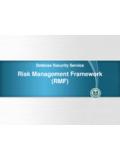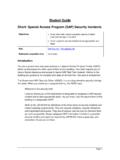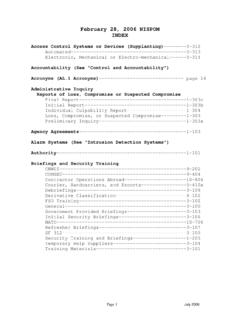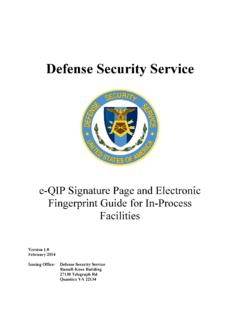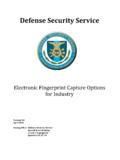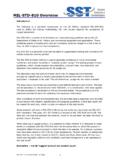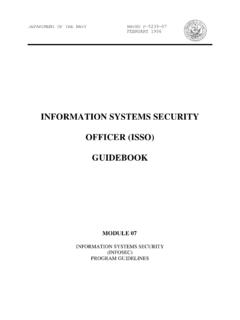Transcription of Productive Distribution Systems - Defense Security Service
1 NSTISSI 13 December 1996 protective Distribution Systems (PDS)THIS DOCUMENT PROVIDES MINIMUM STANDARDS, FURTHERIMPLEMENTATION MAY BE REQUIRED BY YOUR DEPARTMENT OR AGENCYNSTISSNATIONALSECURITYTELECOMMUNIC ATIONSANDINFORMATIONSYSTEMSSECURITY protective Distribution Systems 13 Dec 1996 1 NSTISS NATIONAL MANAGER NATIONAL Security TELECOMMUNICATIONS AND INFORMATION Systems Security FORWARD 1.
2 National Security Telecommunications and Information Systems Security Instruction (NSTISSI) No. 7003, protective Distribution Systems (PDS), provides guidance for the protection of wireline and optical fiber PDS to transmit unencrypted classified National Security Information (NSI). This instruction is effective upon receipt, and supersedes NACSI No. 4009, Protected Distribution Systems , dated 30 December 19981 and Appendix K, NACSEM 5203, Guidelines for facility Design and RED/BLACK Installation, dated 30 June Please check with your agency for applicable implementing documents.
3 2. The major differences between this revision and the previous version are the identification of installation and physical Security practices clarification of certain exempted applications from the approval process, the inclusion of government contractors in the scope of this publication, and the inclusion of detailed installation requirements. 3. Additional copies of this instruction may be obtained from: NSTISSC SECRETARIAT ATTN: V503 STE 6716 NATIONAL Security AGENCY FORT GEORGE G. MEADE, MD 20755-6716 SIGNED KENNETH A.
4 MINIHAN Lieutenant General, USAF protective Distribution Systems 13 Dec 1996 2 PROTECTED Distribution Systems (PDS) SECTION I II III IV SYSTEM V SECTION I - REFERENCES 1. The following references are applicable to the installation and use of PDS: a. Department of State Composite Threat List, distributed periodically b. NSTISSI No. 4009, National Information Systems Security (INFOSEC) Glossary, dated 5 June 1992 c.
5 NSTISSI No. 7000, TEMPEST Countermeasures for Facilities, dated 29 November 1993 d. NSTISSI N. 7001, NONSTOP Countermeasures, dated 15 June 1994 e. NSTISSAM TEMPEST/2-95, RED/BLACK Installation Guidance, dated 12 December 1995 SECTION II - PURPOSE 2. This instruction stipulates approval authority, standards, and guidance for the design, installation, and maintenance of Protected Distribution Systems (PDS). This instruction incorporates a philosophy of risk management in lieu of the risk avoidance philosophy employed in the previous document.
6 Absent specific facts, unique to each facility, suggesting greater or lesser risks, these standards shall be applied. However, sensible risk management practice dictates each facility must be evaluated on its own risks and vulnerabilities based on factors such as location, physical Security , environment, access controls, personnel Security requirements, etc. The overall Security afforded by PDS is the result of a layered approach incorporating various protection techniques. The emphasis is placed on detection of attempted penetration in lieu of prevention of penetration.
7 Criteria called out are based on threat or risk analysis relative to the location of the PDS. This generally results in reduced requirements and cost savings during installation and maintenance of PDS. The decision as to what extent the guidance provided in ANNEX B is followed ultimately rests with the department or agency Approval Authority. protective Distribution Systems 13 Dec 1996 3 SECTION III -SCOPE 3. This instruction applies to Government departments and agencies and their contractors and vendors who use, or are contemplating the use of a PDS to protect the transmission of unencrypted classified National Security information (NSI).
8 This introduction describes the requirements for PDS installed within the (including its territories and possessions) and within LOW and MEDIUM threat locations outside of the United States as described by reference a. The threat within the is low. The use of PDS within a HIGH or CRITICAL threat location (per reference a) is not recommended. If PDS are used in these locations, protection techniques are determined on a case-by-case basis by the Approval Authority (see ANNEX A). 4. The contents of this instruction should be made available to personnel involved in the planning, acquisition, installation, approval, and operation of communications Systems (that process classified NSI) and PDS.
9 SECTION IV - GENERAL 5. PDS are used to transmit unencrypted classified NSI through an area of lesser classification or control. Inasmuch as the classified NSI in unencrypted, the PDS must provide adequate electrical, electromagnetic, and physical safeguards to deter exploitation. Since PDS can be penetrated, given the opportunity and adequate time, a philosophy of detection of attempted penetration is employed in this document. Careful consideration is given to the application before PDS is selected in preference to another INFOSEC system.
10 There may be economic, technical, or operational factors making PDS necessary in comparison to other INFOSEC Systems . Although proper design and installation of PDS are important, continued physical Security integrity after installation is critical. The cost and operational impact of maintaining the Security of the system should be assessed prior to acquisition and installation, since such costs can easily exceed the installation cost. 6. Incidents of tampering, penetration, or unauthorized interception must be reported immediately to the PDS Approving Authority for assessment, and local Security authority for review and initiation of an investigation.

